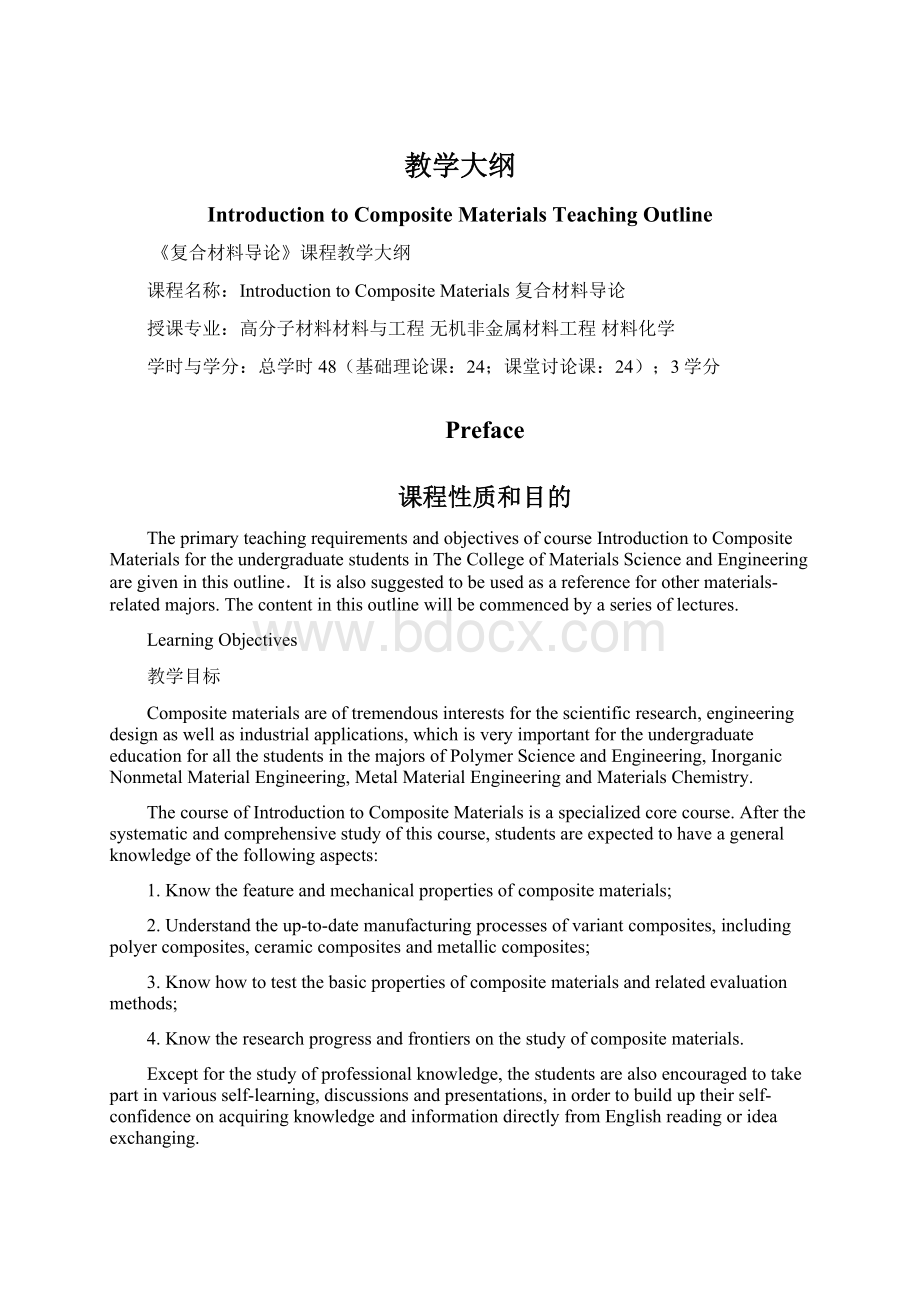教学大纲.docx
《教学大纲.docx》由会员分享,可在线阅读,更多相关《教学大纲.docx(49页珍藏版)》请在冰豆网上搜索。

教学大纲
IntroductiontoCompositeMaterialsTeachingOutline
《复合材料导论》课程教学大纲
课程名称:
IntroductiontoCompositeMaterials复合材料导论
授课专业:
高分子材料材料与工程无机非金属材料工程材料化学
学时与学分:
总学时48(基础理论课:
24;课堂讨论课:
24);3学分
Preface
课程性质和目的
TheprimaryteachingrequirementsandobjectivesofcourseIntroductiontoCompositeMaterialsfortheundergraduatestudentsinTheCollegeofMaterialsScienceandEngineeringaregiveninthisoutline.Itisalsosuggestedtobeusedasareferenceforothermaterials-relatedmajors.Thecontentinthisoutlinewillbecommencedbyaseriesoflectures.
LearningObjectives
教学目标
Compositematerialsareoftremendousinterestsforthescientificresearch,engineeringdesignaswellasindustrialapplications,whichisveryimportantfortheundergraduateeducationforallthestudentsinthemajorsofPolymerScienceandEngineering,InorganicNonmetalMaterialEngineering,MetalMaterialEngineeringandMaterialsChemistry.
ThecourseofIntroductiontoCompositeMaterialsisaspecializedcorecourse.Afterthesystematicandcomprehensivestudyofthiscourse,studentsareexpectedtohaveageneralknowledgeofthefollowingaspects:
1.Knowthefeatureandmechanicalpropertiesofcompositematerials;
2.Understandtheup-to-datemanufacturingprocessesofvariantcomposites,includingpolyercomposites,ceramiccompositesandmetalliccomposites;
3.Knowhowtotestthebasicpropertiesofcompositematerialsandrelatedevaluationmethods;
4.Knowtheresearchprogressandfrontiersonthestudyofcompositematerials.
Exceptforthestudyofprofessionalknowledge,thestudentsarealsoencouragedtotakepartinvariousself-learning,discussionsandpresentations,inordertobuilduptheirself-confidenceonacquiringknowledgeandinformationdirectlyfromEnglishreadingorideaexchanging.
Thebasicscope,rangeandqualityofteachinghavebeenstipulatedintheoutline,whichactsasaguidancefortheteachingandlearningofthecourse.Therequirementof“understand”or“know”hasbeenpointedoutinthe“LearningObjectives”sectionineverychapter.
TeachingContentsandRequirements
教学内容及要求
Outline
PARTIFUNDAMENTALSOFCOMPOSITEMATERIALS
Chapter1IntroductiontoCompositeMaterials
1.1Definitionofcomposites
1.2Compositionofcomposites
1.3Classificationofcomposites
1.4Nomenclature/Terminology
1.5Fabricstructures
1.6Examplesofcommerciallyusedcomposites
Chapter2Mechanicalpropertiesofcomposites
2.1Performanceofcompositematerials
2.2Loadtransferfrommatrixtofiber
2.3Mechanicalproperties
2.4Fracturemodeincomposites
Chapter3Polymercomposites
3.1Introductiontopolymercomposites
3.2Classification
3.3ConstituentsofFiber-ReinforcedComposites
3.4PolymerMatrixComposites
3.5IncorporationofFibersintoMatrix
Chapter4Ceramiccomposites
4.1Introduction
4.2PropertyofCMCs
4.3Thecategoryofceramicmatrixcomposites
4.4Fabricationprocessforceramiccomposites
4.5Machiningandjoining
Chapter5Metalliccomposites
5.1Introduction
5.2Fabricationofmetalliccomposites
5.3Theapplicationofmetallicmatrixcomposites
Chapter6Polymernanocomposites
6.1Introduction
6.2Preparationofnanocomposite
6.3Blending
6.4Sol-GelProcess
6.5InSituPolymerization
6.6ColloidalNanocomposites
6.7Incompatibilityofpolymersandminerals
6.8CharacterizationandProperties
6.9Applications
PARTIIPROGRESSONCOMPOSITEMATERIALS
Chapter7NaturalFiberComposites
7.1Progressandimportanceofplantfibersreinforcedpolymercomposites;
7.2Surfaceproblemoffibre–matrixadhesion;
7.3Approachesformanufacturingall-plantfibercomposites;
7.4Applications
7.5AresearchExample:
Sisalfiberbreakmaterials
7.6Conclusions
Chapter8Polymer/MMTComposites
8.1Introduction
8.2Compositionofpolymer/MMTnanocomposite
8.3Organicmodificationoflayeredsilicates
8.4Nanocompositestructuresandcharacterization
8.5Preparationofnanocomposites
8.6Nanocompositeproperties
8.7Nanocomposites:
advantagesandapplications
Chapter9Polymer/CNT(Carbonnanotube)Composites
9.1Introduction
9.2MechanicalPropertiesofNanotubes
9.3SystemRequirementsforMechanicalReinforcement
9.4PolymerCompositeProcessing
9.5MechanicalPropertiesofPolymer–NanotubeComposites
9.6ConclusionsandFutureOutlook
Chapter10FlameRetardantPolymerNanocomposites
10.1Theneedsoffireretardency
10.2Firestages
10.3Firehazards
10.4Evaluationoffireandfireretardantnanocomposites.
10.5Mechanismofthermaldegradation
10.6Charring,theformationofchar,theroleofchar
10.7Introductiontofireretardancy
10.8Modificationofpolymers
10.9Traditionalfireretardants
10.10Aresearchexample:
Introductiontoflameretardantclaynanocomposites
10.11Otherkindfireretardantnanocomposites
Chapter11MultifunctionalCeramicMatrixComposites
11.1Introduction
11.2MultifunctionalCeramic-Polymercomposites
11.3MultifunctionalCeramic-metalcomposites
11.4MultifunctionalCeramic-ceramiccomposites
11.5Conclusions
Chapter12PiezoelectricComposites
12.1Piezoelectricmaterialcharacteristic
12.2Piezoelectricmaterialtype
12.3Piezoelectriccomposite
12.4Fabricationofpiezoelectriccomposite
12.5Applications
Chapter13StructuralCeramicComposites
13.1Thegeneralintroductiontostructuralceramics
13.2Theprocessingofstructuralceramics.
13.3Silliconnitridecomposites:
Anexample
13.4Principlestotheceramiccomposites.
13.5Mechanismsforparticlesstrengthening.
13.6Moreexamplesofceramiccomposites.
TeachingContentsandRequirements
教学内容与要求
PartI:
FundamentalsofCompositeMaterials
Chapter1Introductionofcomposites
Thebasicdefinition,classificationandcharacteristicsofcompositematerialsareintroducedinthischapter.
【LearningObjectives】
1.Knowthegeneraldefinitionandthepropertiesofcomposites
2.Knowtheclassificationofcompositematerial
3.Understandthecharacteristicsofcomposites
【TeachingContents】
Keypoints:
◆Theuseofdifferenttypesoffabricsandtheimportanceofthefabricdirection
◆Thedifferenttypesofmatrixphasesuponwhichcompositesarebased.
◆Thefunctionoftheprimaryandsecondaryphaseinacompositematerial.
◆Thedifferencebetweensimpleandadvancedcomposites
◆Theadvantagesanddisadvantagesofplasticsandcomposites
1.1.Definitionofcomposites
1.1.1Requirementsforcomposites
vtwoormorechemicallydistinctconstituents
vdistinctinterfaceseparatingconstituents(differentphases)
vsignificantpropertydifference(≧5times)amongconstituents
vsignificantvolumefraction(≧10%)
1.1.2Propertiesofcomposites
vConsistsoftwophasesandhavedifferentphases
vKeeppropertydifferenceamongconstituents
vAvailabletobedesigh
1.1.3Costsofcompositemanufacture
vMaterialcosts--higherforcomposites
▪Constituentmaterials(e.g.,fibersandresin)
▪Processingcosts--embeddingfibersinmatrix
•notrequiredformetalsCarbonfibersorderofmagnitudehigherthanaluminum
vDesigncosts--lowerforcomposites
▪Canreducethenumberofpartsinacomplexassemblybydesigningthematerialincombinationwiththestructure
vIncreasedperformancemustjustifyhighermaterialcosts
1.2.CompositionofComposites
1.2.1MaterialsandCivilization
1.2.2CompositionofComposites
Compositematerialsystem
Øcontinuousphase(matrix)
Ødiscontinuousphases(reinforcements)
1.2.3TypesofCompositeMaterials
ØTherearefivebasictypesofcompositematerials:
Fiber,particle,flake,laminarorlayeredandfilledcomposites.
A.FiberComposites
Ø1-Dgivesmaximumstrengthinonedirection.
Ø2-Dgivesstrengthintwodirections.
ØIsotropicgivesstrengthequallyinalldirections.
ØCompositestrengthdependsonfollowingfactors:
✧Inherentfiberstrength,Fiberlength,Numberofflaws
✧Fibershape
✧Thebondingofthefiber(equallystressdistribution)
✧Voids
✧Moisture(couplingagents)
B.ParticleComposites
ØParticlesusuallyreinforceacompositeequallyinalldirections(calledisotropic).Plastics,cermetsandmetalsareexamplesofparticles.
ØParticlesusedtostrengthenamatrixdonotdosointhesamewayasfibers.Foronething,particlesarenotdirectionallikefibers.Spreadatrandomthroughoutamatrix,particlestendtoreinforceinalldirectionsequally.
ØCermets
✧Oxide–BasedCermets
✧Carbide–BasedCermets
ØMetal–plasticparticlecomposites
ØMetal–in–metalParticleCompositesandDispersionHardenedAlloys
C.FlakeComposites
ØFlakes,becauseoftheirshape,usuallyreinforcein2-D.Twocommonflakematerialsareglassandmica.(Alsoaluminumisusedasmetalflakes)
ØAflakecompositeconsistsofthin,flatflakesheldtogetherbyabinderorplacedinamatrix.Almostallflakecompositematrixesareplasticresins.Themostimportantflakematerialsare:
✧Aluminum
✧Mica
✧Glass
ØBasically,flakeswillprovide:
✧Uniformmechanicalpropertiesintheplaneoftheflakes
✧Higherstrength
✧Higherflexuralmodulus
✧Higherdielectricstrengthandheatresistance
✧Betterresistancetopenetrationbyliquidsandvapor
✧Lowercost
D.LaminarComposites
ØLikeallcompositeslaminarcompositesaimatcombiningconstituentstoproducepropertiesthatneitherconstituentalonewouldhave.
ØInlaminarcompositesoutermetalisnotcalledamatrixbutaface.Theinnermetal,evenifstronger,isnotcalledareinforcement.Itiscalledabase.
ØWecandividelaminarcompositesintothreebasictypes:
✧Unreinforced–layercomposites
(1)All–Metal
(2)Metal–Nonmetal(metalwithplastic,rubber,etc.)
(3)Nonmetal(glass–plasticlaminates,etc.)
✧Reinforced–layerco